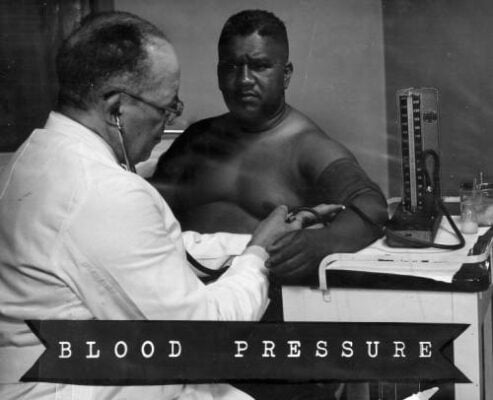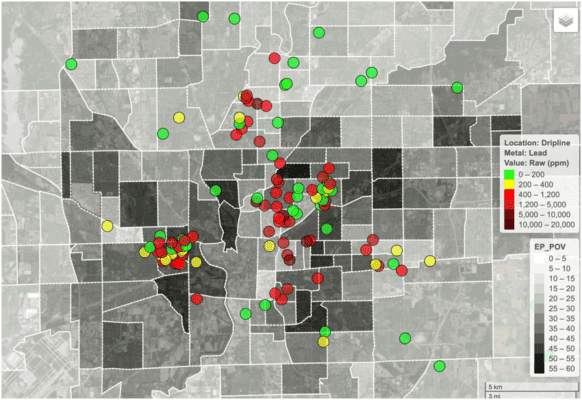Residents of Indianapolis’ Martindale Brightwood neighborhood are confronting stubbornly high rates of hypertension, and public health experts point to lead exposure as a likely contributor.
According to the Marion County Public Health Department (MCPHD) Health Impact Assessment (HIA) for Martindale Brightwood (ZIP codes 46202, 46205 and 46218), the neighborhood “had a higher rate than Marion County” for hypertension hospitalizations and hypertension deaths across multiple time periods analyzed. Those hospitalization rates remained elevated between 2007 and 2021. The HIA also cautions that many factors contribute to hypertension but explicitly lists lead exposure among environmental concerns considered in the assessment.

How lead may raise blood pressure
In a 2007 systematic review published in Environmental Health Perspectives, researchers concluded plainly: “We conclude that the evidence is sufficient to infer a causal relationship of lead exposure with hypertension.”
According to the American Heart Association (AHA), chronic, low-level exposure to contaminant metals such as lead is “associated with an increased risk of cardiovascular disease,” and the AHA’s statement explains that these metals “interfere with essential biological functions and affect most populations on a global scale.” The AHA highlighted that lead accumulates in bones and organs for decades after exposure, increasing long-term cardiovascular risk.
The Centers for Disease Control and Prevention’s National Institute for Occupational Safety and Health (NIOSH)reported that long-term lead exposure can produce “increased blood pressure” as one of the effects of chronic exposure.

What the science shows about levels and risk
A2018 Journal of the American Heart Association analysis indicated that low-level cumulative lead exposure is associated with resistant hypertension and poorer blood pressure control. This suggests that blood pressure may be affected long after a person is exposed to lead.
According to research summarized by the AHA and CDC, lead raises blood pressure through several biological pathways: it can increase oxidative stress and inflammation, alter endothelial function, interfere with nitric oxide signaling, and stimulate the renin–angiotensin system, processes that together promote vascular constriction and hypertension.

Local context: Martindale Brightwood
According to the MCPHD HIA, Martindale Brightwood’s history of industrial contamination, including the former American Lead site, designated a Superfund site by the EPA, creates persistent soil and environmental risks that can contribute to chronic lead exposure in the neighborhood. The HIA notes that many homes in the area were built before 1978, when lead paint was still used, and soil contamination from past industrial activity remains a concern.
According to MCPHD screening data cited in the HIA, only 31% of children under six in Marion County were screened for lead in 2024, and screening rates in the Martindale Brightwood ZIP codes ranged from 27% to 36%. The HIA flagged this as a gap in detection that could allow exposures to go unrecognized.

Why this matters for residents
According to the American Heart Association and multiple epidemiologic studies, even modest increases in blood lead can shift population blood pressure and raise the number of people who meet clinical definitions of hypertension. This effect can increase heart attack, stroke and kidney disease risk over time.
According to MCPHD, the elevated hospitalization and death rates for hypertension in Martindale Brightwood relative to Marion County underscore a health disparity that intersects with environmental injustice. The HIA points out that lower-income neighborhoods and those near industrial sites often face disproportionately high exposure to contaminant metals.

Screening, prevention and public health action
According to NIOSH/CDC guidance, blood lead level reference values and surveillance recommendations exist to identify elevated exposures and protect health. The agency notes that evidence supports lead’s role in increased blood pressure and risk of hypertension even at levels below older regulatory thresholds.
According to public health experts and the MCPHD HIA, reducing the burden of hypertension linked to lead requires both clinical and environmental interventions: clinicians should consider exposure histories for patients with hard-to-control blood pressure, and local governments should prioritize lead hazard remediation, pipe replacement and soil cleanup to reduce ongoing exposure at the community level.
According to MCPHD, residents can request lead risk assessments and blood lead testing from the Marion County Lead Poisoning Prevention Program by calling 317-221-2155 or visiting missionunleaded.org; MCPHD lists resources for housing inspections, testing and case management in the HIA.

Residents concerned about lead exposure can call 317-221-2155 or visit missionunleaded.org to schedule a free blood lead test or home inspection. Additional resources and case management are available through the Marion County Lead Poisoning Prevention Program and the Indianapolis Mayor’s Action Center at 317-327-4622.
This reporting is made possible by a grant from the Indianapolis African-American Quality of Life Initiative, empowering our community with essential health insights. https://iaaqli.org/
Contact Health & Environmental Reporter Hanna Rauworth at 317-762-7854 or follow her on Instagram at @hanna.rauworth.
Hanna Rauworth is the Health & Environmental Reporter for the Indianapolis Recorder Newspaper, where she covers topics at the intersection of public health, environmental issues, and community impact. With a commitment to storytelling that informs and empowers, she strives to highlight the challenges and solutions shaping the well-being of Indianapolis residents.






